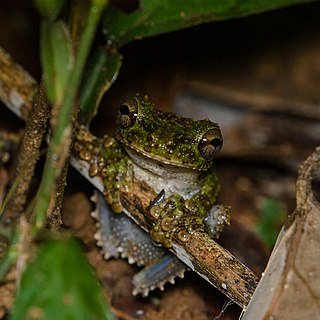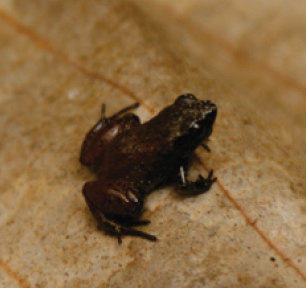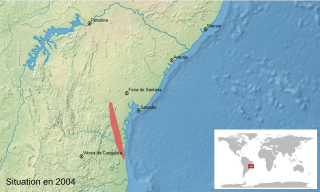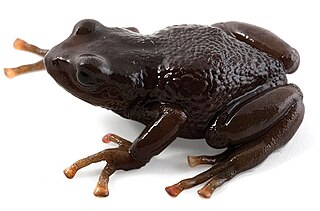
Adelophryne is a genus of frogs in the family Eleutherodactylidae. They are native to northern South America east of the Andes, known roughly from the area corresponding to the Guiana Shield, as well as to the coastal area of Bahia, Brazil. Whether the genus is truly distinct from Phyzelaphryne remains uncertain. Common name shield frogs has been proposed for this genus, although the stem flea frog is used for some species.

Sachatamia ilex is a species of frog in the family Centrolenidae. It is found in eastern Nicaragua, Costa Rica, Panama, western Colombia, and western Ecuador. Common name Limon giant glass frog has been coined for this species, apparently in reference to its type locality in the canton of Limón, Costa Rica, and it is also known as the ghost glass frog.
Nymphargus balionotus is a species of frog in the family Centrolenidae. It is found in the Andes of Colombia and Ecuador. Common names Mindo Cochran frog and mottled glassfrog has been coined for it.

Osteocephalus cabrerai is a species of frog in the family Hylidae. It is found in the Amazon Basin in Brazil (Manaus), northeastern Peru, Ecuador, Colombia, Guyana, and French Guiana, possibly wider. Some earlier records refer to Osteocephalus buckleyi.

Sphaenorhynchus dorisae, the Doris' lime treefrog, is a species of frog in the family Hylidae. It is found in the upper Amazon Basin of southeastern Colombia, Ecuador, Brazil and Peru. It might also be present in Bolivia.

Adelophryne baturitensis is a species of frog in the family Eleutherodactylidae. It is endemic to north-eastern Brazil and is known from its type locality, Serra de Baturité in the state of Ceará.

Adelophryne gutturosa is a species of frogs in the family Eleutherodactylidae. It is found on the Guiana Shield from eastern Venezuela through Guyana to French Guiana and adjacent Brazil (Amapá), possibly extending to Suriname. Its type locality is Mount Roraima. Its local Spanish name is ranita guturosa.

Adelophryne maranguapensis is a species of frog in the family Eleutherodactylidae. It is endemic to Serra de Maranguape, just west of Fortaleza, in Ceará state, northeastern Brazil.

Adelophryne pachydactyla is a species of frog in the family Eleutherodactylidae. It is endemic to the coastal area of south-central Bahia state, Brazil. Some specimens first identified as A. pachydactyla have later been found to represent a new species, Adelophryne mucronatus; the two species can occur in sympatry. The specific name pachydactyla is derived from Greek pachys (=thick) and daktylos (=finger), referring to the thick, short, swollen fingers of this frog.
Pristimantis croceoinguinis is a species of frog in the family Strabomantidae. It is found in the lowland Amazon rainforest of southern Colombia, eastern Ecuador, and extreme north-eastern Peru, likely also extending into the adjacent Brazil. The specific name croceoinguinis refers to the color of the inguinal spots of this frog. Common name Santa Cecilia robber frog has been proposed for it.
Niceforonia dolops is a species of frog in the family Strabomantidae. It is found in the Andes of southern Colombia and northern Ecuador. Specifically, it is known from the Cordillera Oriental and Colombian Massif in Caquetá and Putumayo Departments, Colombia, and Napo Province, Ecuador. Common name Putumayo robber frog has been coined for it.
Pristimantis modipeplus is a species of frog in the family Strabomantidae. It is endemic to the Andes of central Ecuador in Chimborazo, Pichincha, and Tungurahua Provinces. Common name Urbina robber frog has been proposed for it.

Pristimantis orcesi is a species of frog in the family Strabomantidae. It is endemic to the Andes of central and northern Ecuador. The specific name orcesi honors Gustavo Orcés, an Ecuadorian naturalist. Common names Orces robber frog and Bolivar robber frog have been proposed for this species.
Pristimantis scoloblepharus is a species of frog in the family Strabomantidae. It is endemic to Colombia and is only known from three localities in the Cordillera Central in the Antioquia Department. The specific name scoloblepharus is derived from Greek skolos (=pointed) and blepharis (=eyelash) and refers to the large tubercle in its eyelid. Common name Los Patos robber frog has been coined for it.
Pristimantis simonbolivari is a species of frog in the family Strabomantidae. It is endemic to Ecuador and known only from the region of its type locality, Cashca Totoras, Cordillera Occidental, in the Bolívar Province. The specific name simonbolivari honors Simón Bolívar. Common name Simon's ground frog has been proposed for it.

Pristimantis unistrigatus, common name: striped robber frog, is a species of frog in the family Strabomantidae. It is found in the Andean valleys from southern Colombia to central Ecuador.
Pristimantis variabilis is a species of frog in the family Strabomantidae. It is found in the lowland Amazon rainforest and Andean slopes in southern Colombia, eastern Ecuador, eastern Peru, and western Brazil. The specific name variabilis refers to the variable dorsal coloration of this frog. Common name variable robber frog has been proposed for it.
Noblella myrmecoides is a species of frog in the family Strabomantidae. It is found in the upper Amazon Basin of southeastern Colombia, eastern Ecuador, eastern Peru, Bolivia, and western Brazil (Amazonas). Common name Loreto leaf frog has been coined for this species.

Pristimantis acerus is a species of frog in the family Strabomantidae. It is endemic to Ecuador and known from the area of its type locality between Papallacta and Cuyujúathe in the Napo Province and from the Llanganates National Park, Pastaza Province. This species is rated as Endangered by the IUCN. Common name Papallacta robber frog has been coined for it.

Adelophryne mucronatus is a species of frog in the family Eleutherodactylidae. It is endemic to the coastal areas of the Bahia state in eastern Brazil; it is known from the municipalities of Itacaré, Ilhéus, and Una. The specific name mucronatus is derived from Latin and means "pointed", referring to the pointed fingers tips of this frog.











